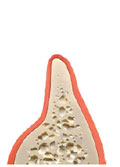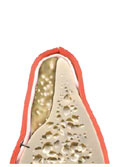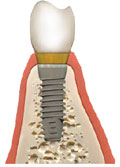Guided Bone Regeneration in NYC & NJ



Grafting Materials
With respect to the Bone Graft material used, we have to differentiate between several choices. All materials can be categorized into five different categories:
- Autograft or autogenous bone graft
- Allograft or allogenic bone graft
- Xenograft or xenogenic bone graft
- Alloplast or alloplastic bone graft
The Autograft is considered the Gold Standard. It is defined as tissue transplanted from one site to another within the same individual. It is basically your very own bone taken from a donor site and placed somewhere else in the body, into the recipient site. The best success rates in bone grafting have been achieved with autografts, because these are essentially living tissues with their cells intact. There is no immune reaction and the microscopic architecture is perfectly matched. The only disadvantage of the autograft is that it has to be harvested from a secondary site in your body, which usually means more morbidity and a more complicated surgery, overall. For most grafting purposes confined to Oral Implantology we can use another part of the jaw (i.e., chin or back portions of jaw) as an acceptable donor site. This way, we stay surgically inside the mouth and avoid any extraoral wounds and scarring. Sometimes, however, when there is not enough bone volume available intraorally, we have to get bone from other parts of the body (usually your hip bone or your tibia (shin) bone) or even from a bottle – alloplast, allograft, or xenograft.
The Allograft is defined as a tissue graft between individuals of the same species (i.e., humans) but of non-identical genetic composition. The source is usually cadaver bone, which is available in large amounts. This bone however has to undergo many different treatment sequences in order to render it neutral to immune reactions and to avoid cross contamination of host diseases. These treatments may include irradiation, freeze-drying, acid washing and other chemical treatments. In the U.S. virtually all donors are being prescreened for infectious diseases before their bone is even accepted into the tissue banks. After that the processing of the bone would eliminate virtually any chance of cross-infection.
The Xenograft is defined as a tissue graft between two different species (i.e. bone of bovine origin). Tissue banks usually choose these graft materials, because it is possible to extract larger amounts of bone with a specific microstructure (which is an important factor for bone growth) as compared to bone from human origin.
The Alloplast usually includes any synthetically derived graft material not (coming) from animal or human origin. In Oral Implantology this usually includes Hydroxyapatite or any formulation thereof.
Each of the bone graft materials is usually developed with a specific purpose or advantage in mind. Some claims made by tissue banks about a certain bone graft material may sometimes have to be taken with a grain of salt, until independent research can verify those claims. The main purpose of using the latter three of the above graft materials is usually to avoid a secondary surgery for harvesting autogenous bone. Your surgeon will make a decision with respect to the bone graft material, based on your individual needs and the latest research in that field.
